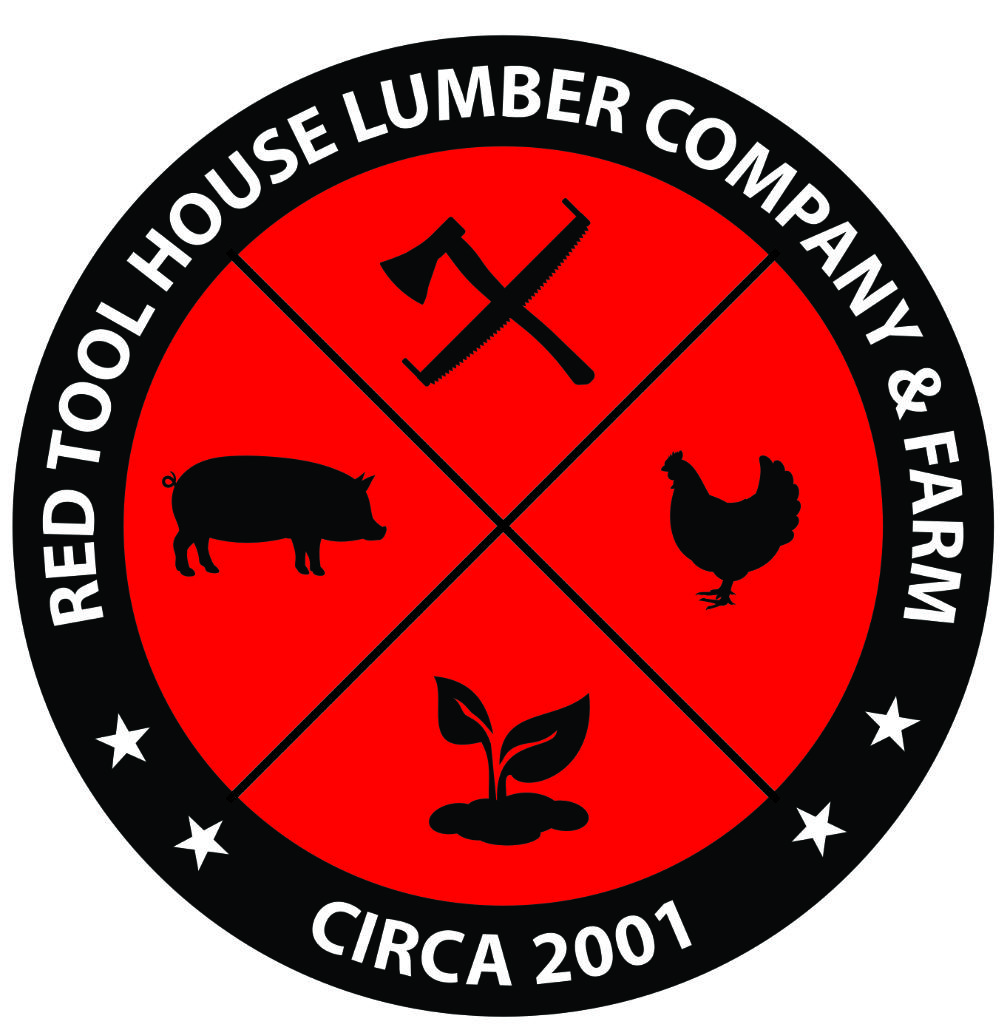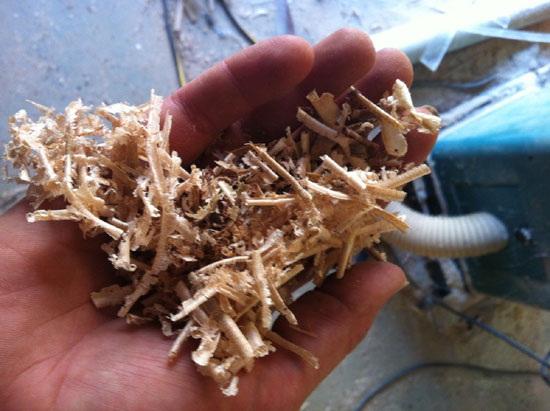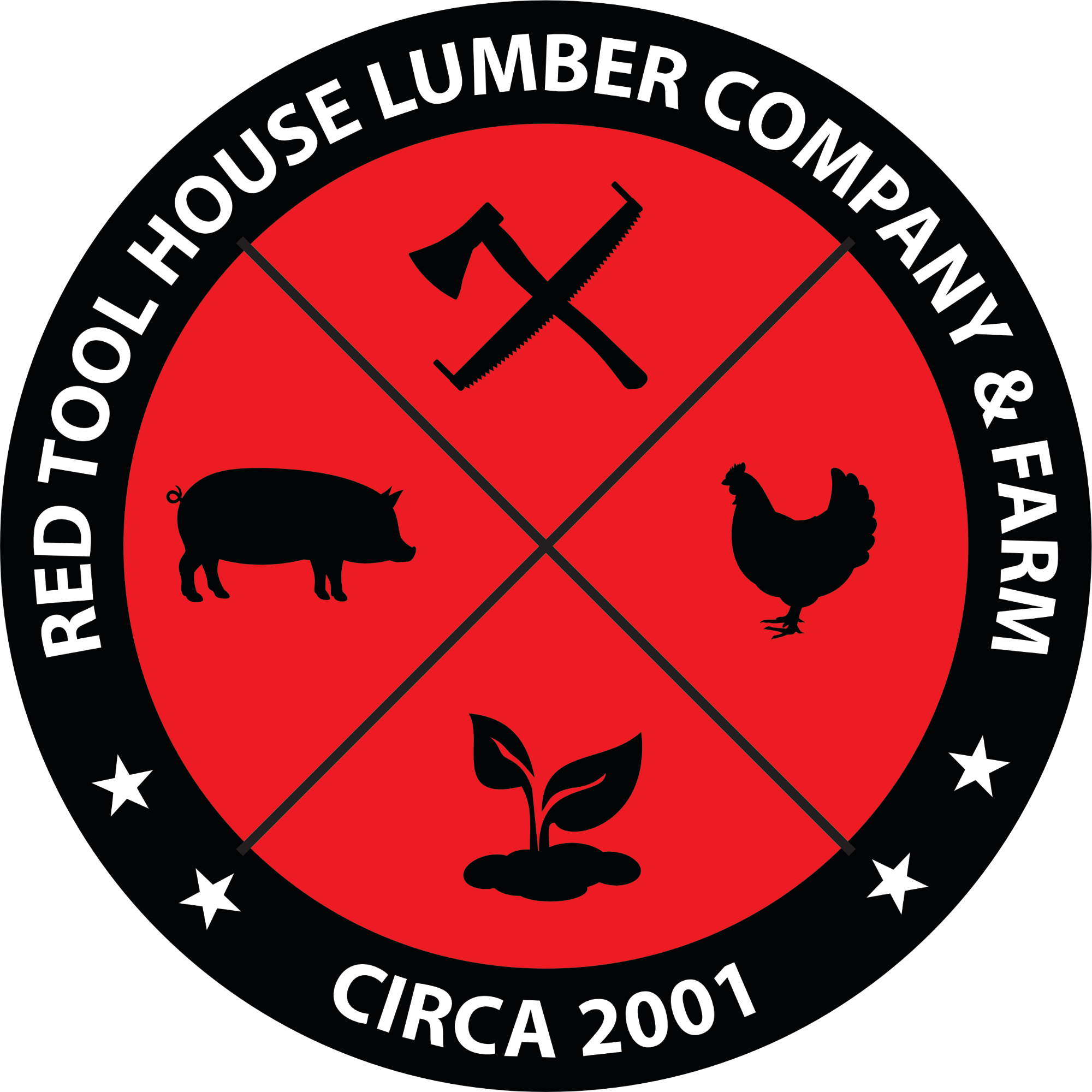Many readers may think I am scraping the bottom of the barrel on content when I decide to write about saw dust. It is, after all, just dust, right? Sawdust has become extremely useful at Red Tool House Lumber Co & Farm and not in the most obvious of areas.
The interesting thing about the woodshop when discussing sawdust is the variation in the dust itself. If the dust is generated by the drum sander or a palm sander, then it is the fine dust that ends up my nose, ears, in my hair, and makes me think a fog has settled in the valley if I forget to clean my glasses before leaving the shop. While this dust is more of a health-risk then a benefit, it is extremely useful in making wood filler. By mixing it with wood glue, I can fill in some joints that may not be as tight as I prefer. It works best on miter joints when there is a slight gap at the joint line.
Sawdust from the bigger equipment is naturally larger and has less tendency to end up in my lungs. The planer, jointer, and trim machine create copious amounts of sawdust. Since a majority of my raw wood material is sawed wood from the mill, it has to be surfaced on both sides before it can be used. This process alone can generate a decent pile of sawdust. Maybe shavings would be a more appropriate word to describe what exists the machine. In the picture above, I am holding some walnut and pine shavings that came from planning several boards.
A typical board from the mill is anywhere from 1.25 inches thick to 1 inch thick depending on how it dried (thus shrinking). The ideal thickness (what you would get from the store) is ¾ of an inch. With a 10 inch wide board 10 feet long, I can make enough sawdust to fill a lawn garbage bag in just a few passes.
One critical piece of equipment needed in the shop is my centralized dust collector. This machine is like a tornado in a can. I think it could literally suck the hair off a cat. My system is mounted to the wall at the back of the shop and discharges the dust out into the backyard of the woodshop (another benefit of rural living). There are various intakes throughout the shop at each workstation and even a floor sweep that I can broom any extraneous dust into. To prevent static electricity issues, the piping is all metal. It is interesting to note that when sawdust moves rapidly through a tube, it creates static electricity. If that static is allowed to build, it could arc inside the tubes and actually ignite the sawdust in suspension!
Two funny stories about the dust collector that I will briefly mention… the first involves the plastic flexible hoses I use to transition from the machine to the fixed tubing. It is generally less than 6 feet long. I was running my drum sander one evening. As large amounts of fine dust were being carried up the tube, the static electricity was building. At one point, I reached across the machine to make an adjustment and I instantly felt the hair on my arm stand on end. Before I could pull my arm back, a large blue arc came off the tube and hit my forearm. It was the equivalent of getting hit by an electric fence and made a loud crack. Needless to say I have rerouted the flexible tubing since then.
The other story may be a little insensitive to you animal lovers, but it bears telling anyway. In my shop, I constantly struggle with mice. It seems the more I trap, the more show up to replace their fallen comrades. One evening I was cleaning out from under my table saw. I had the flexible hose disconnected from the cabinet port and simply lying on the floor while I pushed saw dust toward it. As I moved around the saw cabinet, I startled a small mouse which instantly ran for the nearest cover. That cover happened to be the dust collection tube. In an instant, he was whisked up the tube. It could have been the wildest ride of his life, but the 90 degree turns were a bit hard on him and the fun-house ride came to an abrupt halt when he reached the turbine blades of the fan. At that point, I was very glad the fan exhausted to the outside and not into a collection bag. That would have been a bit messy.
Over the years, I have amassed a large pile of sawdust behind the wood shop. As I became more serious in farming, I soon discovered I had a valuable resource. Sawdust has various benefits on the farm such as:
Perfect bedding for chicks and chickens – Sawdust reacts well with the ammonia in chicken feces and helps neutralize the odor. When it is no longer needed in a coop or brooder, it makes great compost material.
Ideal mulch for acid loving plants – Placing sawdust around plants like strawberry, blackberries, raspberries, and especially blueberries not only helps traps moisture for the roots, but gives the plants the acidic pH it prefers.
Great spill clean up – Oil, gas, kerosene or any liquid for that matter can be soaked up easily with sawdust.
Insulation – A barn or any other outbuilding that needs some temperature regulation can benefit greatly by having the walls filled with saw dust. This works great in a well house or other small structures that house water lines through the winter.
For some reason, kids and large piles of sawdust are attracted to one another. Sawdust manages to get lodged in every possible crack and crevice on children to the point it makes the shower floor look like a horse stable.
If you find yourself appreciating sawdust more after reading this and you don’t have an easy way of creating your own, check with local sawmills in your area. They are usually trying to get rid of it and some may even load your truck or trailer for free. You can also look for woodworkers in your area. They too are most likely trying to rid themselves of the by-product. If your in the Red Tool House area, stop by, we will load you up and may even throw some on your children.








Studies show it takes 30 days of hot composting of black walnut leaves to neutralize the juglone. I don’t know how that works with the shavings nor can I tell how long it takes for the juglone from the root system of the tree to neutralize. I have heard that black walnut leaves make a killer mulch, literally, for areas where you are very selective about what you want growing.
I have heard the same about walnut leaves. I have never tried it. I still see poison ivy growing up the side of walnut trees here on the property. I guess nothing can stop it.